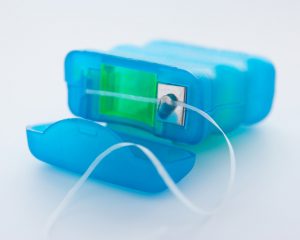Dental Floss Daily: Do You, or Don’t You?
We shed light on the great dental floss debate of 2016, when government agencies backed off on a longtime recommendation to make flossing a regular practice.
Are you someone who has to force yourself to use dental floss? Or are you a floss-aholic, the type who keeps a pack of floss in your car, pocket, or desk drawer so you can constantly clean your teeth?
According to stats, most people fall into the former category. American Dental Association (ADA) data shows that only around 12 percent of Americans floss daily. The other 88 percent must have rejoiced at a controversial 2016 report saying that, well, flossing isn’t all that important.
Let’s review the events leading up to the great dental floss controversy—and consider how experts really feel about the benefits of flossing.

When the latest edition of Dietary Guidelines for Americans came out, flossing was conspicuously absent. The USDA and HHS omitted any mention of dental floss, eliminating a longtime recommendation without fanfare.
The Disappearing Dental Floss Recommendation
In 1979, the U.S. Department of Agriculture (USDA) and the Department of Health & Humans Services (HHS) began recommending the practice of using dental floss every day in conjunction, of course, with brushing. The recommendation came in the form of a surgeon general’s report and also in Dietary Guidelines for Americans, a publication produced every five years.
In 2015, the Associated Press—according to a report by the AP itself—requested evidence that flossing prevents gum disease, cavities, and other dental health issues. Citing the Freedom of Information Act, the AP actually sent written requests for ironclad, research-backed proof that flossing is effective.
When the newest edition of Dietary Guidelines for Americans came out in 2016, presto!—no mention of dental floss. The Associated Press noted the omission, reporting that the USDA and HHS acknowledged that research has never proven the effectiveness of flossing.

You’d be hard-pressed to find dentists who would say, “No, you don’t need to worry about flossing….”
Flossing Studies: What About the Research?
In 2011, the Cochrane Oral Health Group conducted a review of multiple studies and randomized controlled trials that pitted toothbrushing and flossing versus toothbrushing only. The research involved a total of nearly 1,100 adults.
The results, according to the Cochrane Library study’s authors, showed that there’s evidence from 12 studies that flossing in addition to toothbrushing reduces gingivitis compared to toothbrushing alone.
The authors also said that there’s “weak, very unreliable evidence from 10 studies that flossing plus toothbrushing” reduces plaque. And, they added, no studies have verified “the effectiveness of flossing plus toothbrushing for preventing dental caries.” (“Caries” means tooth decay.)
This summary passage from the Cochrane Library describes the effect of plaque on our teeth—and the perceived role of flossing:
“It is assumed that removing plaque (a layer of bacteria in an organic matrix which forms on the teeth) will help prevent gum disease (gingivitis) and tooth decay (dental caries). Gum disease, which appears as red, bleeding gums, may eventually contribute to tooth loss. Untreated tooth decay may also result in tooth loss. Toothbrushing removes some plaque, but cannot reach in-between the teeth, where gum disease and tooth decay are common. This review looks at the added benefit of dental flossing, in people who brush their teeth regularly, for preventing gum disease and tooth decay.
“Twelve trials were included in this review, which reported data on two outcomes (dental plaque and gum disease). Trials were of poor quality and conclusions must be viewed as unreliable. The review showed that people who brush and floss regularly have less gum bleeding compared to toothbrushing alone. There was weak, very unreliable evidence of a possible small reduction in plaque. There was no information on other measurements such as tooth decay because the trials were not long enough and detecting early stage decay between teeth is difficult.”
Is Flossing Overrated—or Underemphasized?
On the heels of the flossing controversy, New York Times health writer Catherine Saint Louis reported (perhaps tongue in cheek), “For decades, the federal government—not to mention your dentist—has insisted that daily flossing is necessary to prevent cavities and gums so diseased that your teeth fall out. Turns out, all that flossing may be overrated.”
But is it actually overrated?
You’ll find plenty who stand by flossing—including the ADA and, yes, both the USDA and HHS.
- After the AP story appeared in July 2016, the DHHS did some backtracking (and, perhaps, damage control) by releasing this statement: “Flossing is an important oral hygiene practice. Tooth decay and gum disease can develop when plaque is allowed to build up on teeth and along the gum line. Professional cleaning, tooth brushing, and cleaning between teeth (flossing and the use of other tools such as interdental brushes) have been shown to disrupt and remove plaque.”
- The ADA released a reaffirmation that flossing, covered broadly under the phrase “interdental” cleaning, is important. “Interdental cleaners such as floss are an essential part of taking care of your teeth and gums,” according to the ADA. “Cleaning between teeth removes plaque that can lead to cavities or gum disease from the areas where a toothbrush can’t reach. Interdental cleaning is proven to help remove debris between teeth that can contribute to plaque buildup.”The ADA added, “More than 500 bacterial species can be found in plaque; some are good and some are bad for your mouth. Together with food debris, water and other components, the plaque buildup around the teeth and on the gum line will contribute to disease in teeth and gums.”
- Dr. Andrew Swiatowicz, writing at Huffington Post, is unequivocal in his support of flossing: “No study, and certainly no dentist, would ever claim or even imply that flossing is harmful. You would be hard-pressed to find a study that concludes a person’s health is improved by eliminating flossing from her oral health routine. In fact, the conclusion that most studies draw is that even though the data are limited, the potential benefits of flossing outweigh the risks.”
- Michael J. McDevitt, D.D.S. and Diplomate of the American Board of Periodontolgy, wrote at Spear Education’s website that “effective flossing two to three times a day has been a core principle in my strategy for success” in treating patients experiencing periodontitis. Dr. McDevitt, by the way, recommends unwaxed floss over waxed, writing that it more thoroughly removes plaque.
ARE YOU DOING IT RIGHT?
The ADA-approved site Mouth Healthy offers “5 Steps to a Flawless Floss,” an illustrated guide to thorough flossing.
The bottom line: After seeing the 2016 headlines, you may have been swayed by the headlines that downplayed flossing, but experts still will tell you that flossing is a “best practice” for good dental hygiene. Avoid it at your own peril.
GREAT MOMENTS IN FLOSSING: DID CAVEMEN FLOSS?
Cleaning those tight spaces between our teeth can be a chore—one that confronted even early man. Hey, it had to be tough to get wildebeest meat dislodged from those back molars! According to author Denise Prichard writing at SpearEducation.com, “Discoveries made by researchers have suggested that cleaning between the teeth was practiced as early as the Prehistoric period.” Horse hair may have been used as floss, with twigs used as toothpicks.
In 1818, Dr. Levi Spear Parmly, an American dentist, “introduced the idea of using waxed silken thread as floss,” according to Prichard. But the Oral-B company credits an unnamed New Orleans dentist for using thin silk thread for cleaning between teeth as early as 1815.
In 1882, Codman and Surleft Co. in Randolph, Mass., began mass-producing unwaxed silk floss, and 16 years later, in 1898, Johnson & Johnson scored the first dental floss patent.
In the 1940s, nylon replaced silk as the top floss material and led to waxed floss. By now, such materials as PTFE (which stands for the unwieldy word polytetrafluorethylene, the material used in hi-tech Gore-Tex fabric), spongy floss, and yarn-like soft floss and super floss provide variety among dental floss offerings.


 Hearing Aids Extend Longevity
Hearing Aids Extend Longevity  How to Fix a Droopy Eyelid
How to Fix a Droopy Eyelid  Droopy Eyelids Can Interfere with Vision
Droopy Eyelids Can Interfere with Vision 
Do you use dental floss every day? Regardless of the great flossing controversy of 2016, most experts agree it's an important routine.
© Jonathan Ross | Dreamstime.com